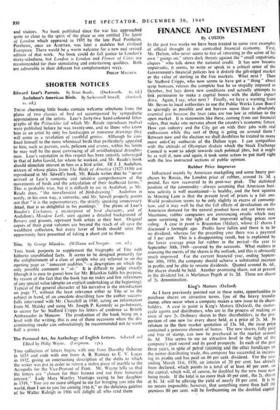SHORTER NOTICES
Eth‘ard Lear's Parrots. By Brian Reade. (Duckworth. 8s. 6d.)
THESE charming little books contain welcome selections from the plates of two classics of bird art accompanied by sympathetic
appreciations of the artists. Lear's forty-two hand-coloured litho- graphs of the Psittacidae (of which Mr. Reade reproduces twelve) were published before he was twenty-one, and to those who know him as an artist by only his landscapes or nonsense drawings they will come as a revelation of youthful genius. Although he con- fined himself to the more whimsical birds that particularly appealed to him, such as parrots, owls, pelicans and cranes, within his limits be may well be the most convincing of all ornithological draughts. men. Lear's reputation in this respect has been unjustly subii'erged in that of John Gould, for whom he worked, and Mr. Reade's book should stimulate interest in him as a bird artist. Of J. J. Audubon, sixteen of whose plates from The Birds of America (1827-1830) are reproduced in Mr. Sitwell's book, Mr. Reade writes that he " never arrived at Lear's romantic and intuitive comprehension of the movements of birds and the articulation of their feathered forms." This is probably true, but it is difficult to see in Audubon, as Mr. Reade does, " the neo-classicist of bird-drawing." Audubon is surely, in his own way, a romantic, and Mr. Sitwell properly points out that " it is the supernumerary, the strictly speaking unnecessary detail, that is so delightful in his paintings." The plates of Lear's Baudin's Cockatoo, a masterpiece of bird character, and of Audubon's Meadow Lark, seen against a detailed background of flowers and grasses, represent both artists at their best. Original copies of their great volumes are beyond the reach of all save the wealthiest collectors, but every lover of birds should seize the opportunity here presented of taking a short cut to them.






























 Previous page
Previous page